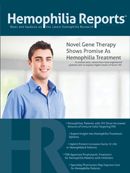Publication
Article
Hemophilia Reports
Racing Toward an Interferon-Free Treatment
Interferon is the therapeutic backbone of HCV treatment, as well as the major barrier to HCV treatment access, uptake, and completion. This summation of the key problem in treatment of HCV opens an HCV pipeline report from the HCV Treatment Action Group.1 As welcome as telaprevir and boceprevir are, they have not razed the interferon barrier.
The promise of drugs now in the treatment pipeline is to bring an interferon-free treatment to market. General estimates suggest that only 10% to 20% of those who know they are infected will undertake therapy that includes interferon and go on to complete the regimen.2 The launch of two successful therapies in 2011 raised the bar even higher: New agents in development are now challenged to be as effective as the protease inhibitors telaprevir and boceprevir, as well as more tolerable than interferon.
Challenges in drug development
There are many avenues of exploration just opening to trials with patients. Early studies identified multiple steps in the hepatitis C viral lifecycle that offer potential pharmacologic targets. In response, pharmaceutical developers have already created at least five distinct classes of agents to attack differing aspects of the viral RNA chain.3,4
Creating without a template: This is very new science. Although protease inhibitors have been used previously to treat HIV, the ones currently being used for HCV are very specific—targeted, direct acting. Telaprevir and bocepervir precisely inhibit the HCV nonstructural protein 3/4A (NS3/4A) serine protease.3 Other DAAs are being developed to interrupt viral replication at completely different targets. Among agents in development, those closest to launch include:
• Nucleoside/tide polymerase inhibitors
• NS5A protease inhibitors
• NS3/4A protease inhibitors
• Non-nucleoside/tide reverse transcriptase inhibitors
Resistance: Viruses regularly mutate, and HCV has shown itself to be exceedingly agile in this respect. When telaprevir and boceprevir were used without interferon, both rapidly selected for resistance variants, leading to virologic failure. Combining either agent with peg-IFN and ribavirin, however, protects against the selection of resistant variants, and the antiviral response strengthens.3
We know that HCV patients have differing responses to hepatitis C antivirals depending on which viral genotype the patient (host) is carrying. The sidebar on page 2 lists the six genotypes that Racing Toward an Interferon-Free Treatment have been identified so far, and they seem linked to hereditary ethnic origin.
If six variants were the only problem, the issue would probably have been solved already. However, there are over 50 subtypes within those six genotypes. These different “strains” of hepatitis C virus have resulted from the uncommonly high chance of mutation in its genetic code when the virus replicates—resulting in the development
of very similar but technically different types of hepatitis C virus.4 In the United States, 57% of people with HCV have genotype 1a; 17% have genotype 1b. Genotypes 2 and 3 are the next most common.5
New therapies have also been able to raise cure rates in some populations that had high incidences of chronic hepatitis C but persistently low success rates when treated with the original SOC regimen. For example, the addition of DAAs did improve cure rates in African American and Hispanic patients, but not as much as they improved outcomes in Caucasian patients.3 It is possible that these longrecognized disparities may represent a clinical subtype difference that could be addressed by new targeted therapies without interferon,3 but at this point, there are no trial data to support that hope.6
Meeting global needs: As long as interferon remains as the base of HCV therapy, it is unlikely that the millions of people with HCV across the world will benefit from advances in treatment. The need for a cure is most acute in underdeveloped parts of the world, where it is impossible to administer a parenteral therapy on a daily basis and just as impossible to monitor patients for the serious side effects that would emerge.
Thus, the hope is to see combination therapies emerge from the HCV drug pipeline in oral formulations. Researchers are seeking potent combinations of three or more DAA agents, each targeting different aspects of the virus, with the goal of inhibiting HCV replication and suppressing drug resistance. Nucleosides/nucleotides and protease inhibitors could be the preferred backbone in a combination regimen because they have different modes of action, complementary resistance profiles,
and broad genotypic activity. Potent NS5A inhibitors and non-nucleosides could be the third or fourth component of a DAA combination treatment.7 It is possible, according to early stage outcomes, that such treatments may approach 90% cure rates for broad categories of patient types.8 Two to five years—that’s the hope.
References
1. Treatment Action Group. The Hepatitis C Treatment Pipeline Report. Available at: http://www.treatmentactiongroup.org/ hcv/publications/2011/hcvpipeline2011.
2. Mitchell AE, et al. Hepatology. 2010;51:729-723.
3. Ghany MG, et al. Hepatology. 2011;54:1433-1444.
4. Pawlotsky JM. Hepatology. 2011;53:1742-1751.
5. New York Times. About.Com: Hepatitis. Available at: http://hepatitis.about.com/od/questions/f/genotype_HCV.htm.
6. HCV Advocate Newsletter. Available at: hcvadvocate.org/ news/newsletter/2012.
7. Idenix Hepatitis C Pipeline Fact Sheet. Available at: http://www.idenix.com/antiviral/product.html.
8. Alter HJ, Liang TJ. Ann Intern Med. 2012;156:317-318.






